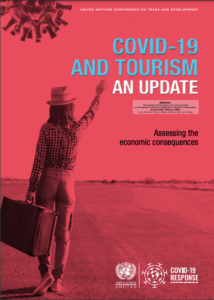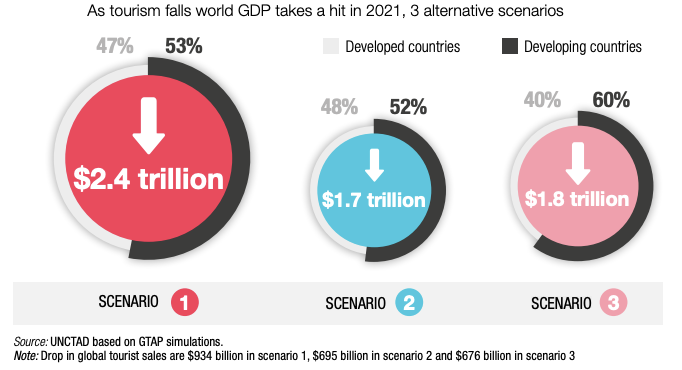
 Geneva: The crash in international tourism due to the COVID-19 pandemic could cause a loss of more than $4 trillion to the global gross domestic product (GDP) last year and this year, a new joint study conducted by the United Nations World Tourism Organization (UNWTO) and United Nations Conference on Trade and Development (UNCTAD) has revealed.
Geneva: The crash in international tourism due to the COVID-19 pandemic could cause a loss of more than $4 trillion to the global gross domestic product (GDP) last year and this year, a new joint study conducted by the United Nations World Tourism Organization (UNWTO) and United Nations Conference on Trade and Development (UNCTAD) has revealed.
The UNWTO reports that tourism experts do not expect a return to pre-COVID arrival levels until 2023 or later. Hence, with tourism not expected to fully recover until perhaps 2023 the policy question is whether and how to support the sector until that time.
It estimates that 100 – 120 million direct tourism jobs are at stake.
The estimated loss is due to the pandemic’s direct impact on tourism and the ripple effect on other closely-linked sectors, and, according to the report released on June 30, 2021, the tourism sector’s recovery will largely depend on the uptake of COVID-19 vaccines globally.

The report suggests that the number of international tourist arrivals declined by 74 per cent in 2020 compared with the previous year (UNWTO Tourism Dashboard). In many developing countries, arrivals were down by 80-90 per cent.
“The beginning of the year 2021 has been worse for most destinations, with an average global decline of 88 per cent as compared to pre-pandemic level, although the northern summer and autumn may see a significant improvement for some destinations, in particular for domestic and regional travel,” the report said.
The indirect effects of this decline are even more devastating, as labour and capital remain unused and the lack of demand for intermediate goods and services has a negative upstream effect into many sectors.
Tourism is an important source of income for many developing countries, accounting for 50 % of total exports for many small economies, particularly Small Islands Developing States such as Maldives and Saint Lucia. Tourism has relatively low barriers to entry and employs a high share of young people and women. UNWTO estimates that 100-120 million direct tourism jobs are at stake.
The most affected regions, according to the report, are North-East Asia, South-East Asia, Oceania, North Africa and South Asia. Least affected regions are North America, Western Europe and the Caribbean. This shows that the greatest impact has fallen on developing countries. The reduction in tourist arrivals across developing nations is relatively consistent, mostly between 60 and 80 per cent.
Working on possible scenarios for 2021, the report offers three scenarios which it says are consistent with UNWTO projections for 2021.
The first scenario is a reduction in tourist arrivals as observed in 2020. Reductions averaged 74 per cent with considerable variation between countries. This average reduction is close to the 75 per cent reduction in UNWTO’s pessimistic scenario.
The second scenario is a reduction in arrivals averaging 63 per cent, which the UNWTO sees as an optimistic outcome in 2021.
The third scenario takes into account varying rates of vaccination and assumes a 75 per cent reduction in countries with low vaccination rates, and a 37 per cent reduction in countries with relatively high vaccination rates.
The cut-off point is economies with 50 per cent of their population vaccinated at the end of May. There are 55 such economies, according to Our World in Data. This includes major destination countries such as the United States, Italy, France and Spain as well as many smaller economies.
The report says that depending on employment effects, the indirect effects of a drop in tourism receipts increase the cost.

This ratio varies greatly across countries, from one to three or four-fold. This depends on the backward linkages in the tourism sector, including the unemployment of unskilled labour. The effect is somewhat greater for developing countries, as some developing countries are much more dependent on tourism.
The report estimates that a partial recovery, from a loss of 74 per cent to 63 per cent, reduces the loss in global GDP by 30 per cent to $1,696 billion. With the benefit of vaccinations being more pronounced in some countries than others, losses are reduced in most developed countries but are worsened in developing countries where the absence of widespread vaccinations keeps tourists away.
The major beneficiaries in absolute terms are the United States, France, Germany, the United Kingdom and Switzerland. These countries have high levels of tourists and high vaccination rates, while the developing countries will carry the greatest burden. Globally, the blow to international tourism given by COVID-19 has caused a loss in GDP of more than $4 trillion only for the years 2020 and 2021, if indirect effects are taken into account.

The estimated GDP effects of the observed loss in tourism receipts are shown in the following figure:

Labour market effects: The estimated losses in employment of unskilled labour due to the fall in tourist arrivals is shown in the figure below. The losses vary according to the proportion of unskilled labour employed in the tourism industry and the extent to which the tourism sector is hit in a specific economy. There is a somewhat similar fall in wages and rates of return for skilled labour and capital.

If labour and capital could be readily re-employed in other industries, the overall impact of a fall in demand for international tourism would be somewhat less than its direct effects. The loss of tourism receipts would be partially offset by output in other sectors. The report outlines three policy dimensions which it says are important to bring tourism back on track —
-
- Vaccinations seem the most important element
- It is important to mitigate the socio-economic impacts on livelihoods. Developed countries have used fiscal measures to support tourism businesses and workers. This is essentially borrowing from the future, and while helpful as a transitionary measure, incurs a debt that will need to be repaid at some stage. Where the support is for otherwise healthy businesses, it is likely to pay off. This strategy is a challenge for most developing countries in particular where tourism is large. Social security nets do often not exist, and informality is high. Workers should be protected rather than specific jobs in declining sectors, for example through training.
- Countries need to make strategic decisions regarding the future of tourism in their countries. Some tourism businesses will not survive even once travel restrictions are removed. Governments need to decide which to support and for how long. Long term implications of the pandemic need to be considered. Developing countries dependent on tourism might consider how they can diversify resources away from tourism.
– global bihari bureau






Hello, its my first time to commenting anyplace, when i read this piece of writing i
thought i could also make comment due to this sensible article.